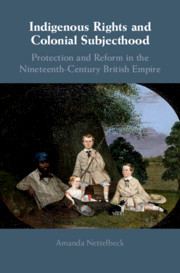 Indigenous Rights and Colonial Subjecthood
Indigenous Rights and Colonial Subjecthood Book contents
- Indigenous Rights and Colonial Subjecthood
- Indigenous Rights and Colonial Subjecthood
- Copyright page
- Contents
- Figures
- Acknowledgements
- 1 Protection and the Ends of Colonial Governance
- 2 Creating Aboriginal Subjects of the Crown
- 3 Distinctive Designs: Local Arenas of Protection
- 4 Protector Magistrates: Mediating Labour and Law
- 5 Intimate Encounters with Protection
- 6 Recasting Protection from Rights to Surveillance
- Conclusion: Protection and Reform in the British Empire
- Bibliography
- Index
5 - Intimate Encounters with Protection
Published online by Cambridge University Press: 21 March 2019
- Indigenous Rights and Colonial Subjecthood
- Indigenous Rights and Colonial Subjecthood
- Copyright page
- Contents
- Figures
- Acknowledgements
- 1 Protection and the Ends of Colonial Governance
- 2 Creating Aboriginal Subjects of the Crown
- 3 Distinctive Designs: Local Arenas of Protection
- 4 Protector Magistrates: Mediating Labour and Law
- 5 Intimate Encounters with Protection
- 6 Recasting Protection from Rights to Surveillance
- Conclusion: Protection and Reform in the British Empire
- Bibliography
- Index
Summary
- Type
- Chapter
- Information
- Indigenous Rights and Colonial SubjecthoodProtection and Reform in the Nineteenth-Century British Empire, pp. 135 - 162Publisher: Cambridge University PressPrint publication year: 2019


